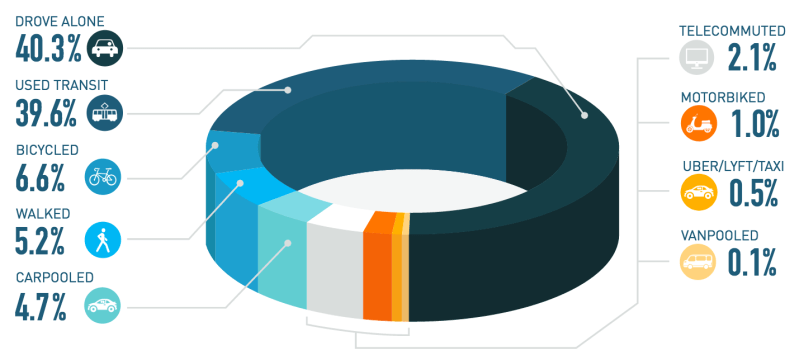Solo Car Commuters Now Outnumber Transit Commuters Downtown

Continuing a troubling trend, last year the number of downtown workers who drove solo to their jobs exceeded the number who took the bus or the train, according to the annual Downtown Denver Partnership commuter survey.
It’s the first time driving alone has exceeded transit in the five years since the Partnership finalized its methodology, despite the Regional Transportation District opening two commuter rail lines and the Flatiron Flyer bus service along U.S. 36.
Meanwhile, the share of people who bike to work downtown remained essentially unchanged, while the share of people who walk decreased slightly.
What else does this new data tell us?
Transit is more appealing to some suburbanites than for Denverites
In some far-flung areas, transit commuting is more common than in closer-in parts of Denver, the survey found. More people from Littleton, Broomfield, Ken Caryl, and Superior use transit to get downtown than any other zip code RTD serves. Those residents can ride trains that don’t get bogged down in car traffic, or take buses that can bypass congestion in HOV lanes (or the shoulder) on the U.S. 36 corridor.

Most Denver neighborhoods, on the other hand, rely on buses that don’t come frequently and share lanes with rush hour car traffic. Even people who live within five miles of downtown are more likely to drive solo than take transit (though they are much more likely to walk or bike than people who live farther away).
“I absolutely think that transit services from the suburban areas of Denver offer very competitive service with driving alone,” said Aylene McCallum, director of downtown environment for the Partnership. “When you look at the transit service in central Denver, even though this group of commuters probably has the most diverse set of options… those options may not necessarily be very competitive with driving alone. They stop very frequently, the services are delayed, they still don’t come at a frequency that is desirable for those riders. So it’s just not a very competitive service.”
Better transit service could win a lot of converts: 57 percent of solo drivers said they’d take transit if the service was “faster or more frequent.” The Hancock administration is considering buying up RTD service to make it more frequent as part of the Denveright transit revamp, which would help. So would prioritizing transit on streets with true bus-only lanes separated from general traffic.
Employee benefits, or lack thereof, make a big difference
Downtown employees who receive parking passes from their employers are 88 percent more likely to drive alone and 44 percent less likely to use transit. Conversely, when firms pay for transit passes, their employees are 67 percent more likely to ride the bus or train, and 28 percent less likely to drive alone.
RTD’s EcoPass, which offers unlimited rides at a discounted rate to bulk buyers, is a great way for downtown businesses with five or more employees to incentivize transit, McCallum said. The EcoPass is a bargain: Parking spaces cost $150 to $200 per month, on average, according to the report, while EcoPasses cost an average of $40 per month per employee.

“We know that when those [transit] passes are put into people’s hands, they’re far more likely to use them,” said Aneka Patel, transportation outreach specialist for the Partnership. “A lot of companies are also providing parking benefits, and so when you have to choose and if you’re getting a significant discount on parking, even if you still have a transit pass, a lot of people are more likely to drive.”
The Partnership wants companies to know the benefits of subsidizing transit for their employees.
“It really has a lot of impact on employee retention, their satisfaction,” McCallum said. “And how happy they are and how stressed out they are, and how ready they are to work and how efficient they are at work.”

The trend is, obviously, headed in the wrong direction
The survey results come on the heels of 2015 census data that show the citywide solo car commuting rate is at 73 percent and rising. The Hancock administration’s stated goal is to get that down to 60 percent by 2020.
An audit released last week found the Hancock administration guilty of setting those sustainability goals — which also include a biking and walking mode share of 15 percent — without a real plan to get there.
Denver is falling far behind its American peer city that’s leading the way. Seattle is working to get its share of single-occupancy vehicle trips down from 30 percent to 25 percent.


